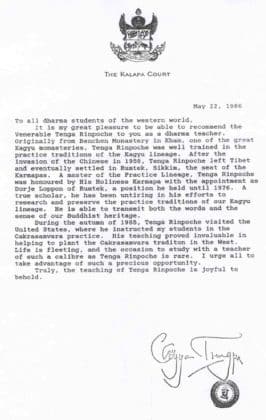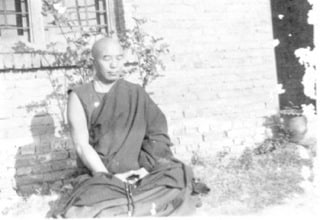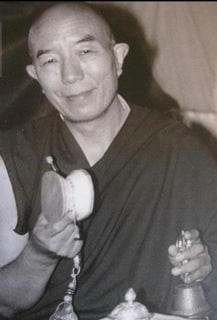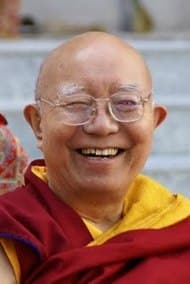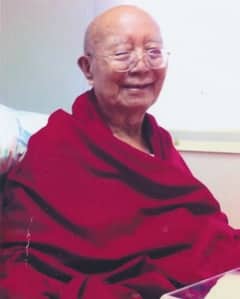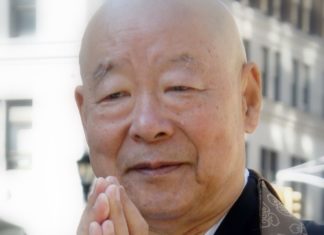It is with great sadness that Vajrayana practitioners around the world receive the news that Kyabje Tenga Rinpoche passed away on Friday 30 March at 3:30 am at his monastery in Kathmandu. Although he had been ill for some time, his death is a shock to everyone. He was a guiding light of the Kagyu dharma, and one of the last great masters of his generation.
Venerable Tenga Rinpoche and his Relationship with the Shambhala Sangha
By Larry Mermelstein
Ven. Tenga Rinpoche had a very long and important association with the Vidyadhara Chögyam Trungpa Rinpoche and our Shambhala community. As the Dorje Loppon of Rumtek Monastery for nearly a decade, he served H.H. the Gyalwang Karmapa very closely, accompanying him on his first tour to North America and Europe in 1974. For many of us, this was our first encounter with Tenga Rinpoche, paving the way quite literally for His Holiness, including drawing the eight auspicious symbols in chalk before His Holiness arrived somewhere, as well as preparing all the many rituals and empowerments he gave.
Tenga Rinpoche’s root guru was the 9th Sangye Nyenpa Rinpoche, the elder brother of Dilgo Khyentse Rinpoche, and so he was very much part of our close family of lineage gurus. During the years that the Sakyong lived in Nepal, studying with H.H. Khyentse Rinpoche, Tenga Rinpoche was a frequent visitor, receiving teachings and transmissions from His Holiness, as well as doing the same for him–both of them sharing seemingly everything they could with each other.
At the personal request of the Vidyadhara, Tenga Rinpoche came to Boulder in 1985 for two months in order to give very detailed teachings on the Chakrasamvara practice to the Nalanda Translation Committee, meeting every morning with us, as well as advising us on the refinement of their translations. His instruction became the heart of our Chakrasamvara Sadhana Practice Manual. Tenga Rinpoche also built the three-dimensional mandala palace of Chakrasamvara, working on this at Marpa House every afternoon. Toward the end of his visit, he offered a very special and elaborate mandala offering ceremony for the Vidyadhara’s health. The Translation Committee continued to visit with Tenga Rinpoche periodically over succeeding years to further enrich his practice instructions for our sangha.
After the parinirvana of the Vidyadhara in 1987, as directed by H.H. Dilgo Khyentse Rinpoche, Tenga Rinpoche became the principal advisor and chief architect for the Great Stupa of Dharmakaya at Shambhala Mountain Center, working closely with Robert King and Joshua Mulder, among many others. He came to consecrate the ground for the stupa in 1991. He also consecrated the ground for the Sacred Studies Hall.
Furthermore, in 1991, at the suggestion of H.H. Dilgo Khyentse Rinpoche and the request of Sakyong Mipham Rinpoche, Tenga Rinpoche returned to Boulder and Halifax in order to give detailed instructions on the six dharmas of Naropa practices, including instructions on the principal trulkhor (yogic postures). He insisted on demonstrating them himself, despite his advanced age, much to the concern of his staff. In Halifax, he trained several students to be able to teach others these postures, working with them daily. That typified his teaching: tirelessly and continually presenting the dharma, extending kindness and warmth to everyone without exception, with no regard for body and life.
That same visit, he performed a complete Chakrasamvara drupchen (“great practice”) in preparation for conferring the Chakrasamvara abhisheka in Halifax. During that time, he completed his instruction for performing the drupchen by showing us how to create the sand mandala. He returned again in 1998 to provide more instruction on the six dharmas, and he conferred the Vajrayogini abhisheka at Shambhala Mountain Center. Tenga Rinpoche also bestowed the Vajrayogini abhisheka for our community at Dechen Choling in 1999.
Over many years, we have continued to consult with and benefit greatly from Tenga Rinpoche’s profound learning and realization, and his compassionate care for these ancient and special vajrayana practices of the Kagyu lineage have caused them to flourish among the many devoted students in the West. We will miss him dearly.
Then I Will Try Especially Hard
By Chris Keyser
Sunday morning in mid-February 1995 dawned clear and sunny at Pullahari monastery in Nepal. At first blush it seemed like any other Sunday morning. My fellow students and I who were studying with Khenpo Tsultrim Gyamtso Rinpoche at the new Rigpe Dorje Institute at Jamgon Kongtrul Rinpoche’s monastery were finishing a relaxed breakfast before heading down to Kathmandu to do our various errands on our weekly day off.
Heleni, an aging but impish Greek lawyer, confided to me that she had practiced Tara that morning to “protect” her from spending too much money in town.
One of the monks appeared in the dining hall and told me that Tenzin Dorje, Jamgon Kongtrul’s energetic and generous general secretary, had sent for me because my mother had called me from California. As I headed up the hill, I speculated that there were only three reasons why my mother would have called me in Nepal. Something must have happened to either my beloved 10-year-old tabby cat and dharma protector Shiwa, my father – who had been ill, or my oldest and dearest friend Jeff, who had AIDS and lived in Los Angeles like my parents.
When I reached Tenzin Dorje’s room he was talking on the monastery’s only phone. When my mother called back she conveyed the worst possible news. After I left for Nepal a month earlier, Jeff, who had been a brother to me since my own brother died of leukemia when we were teenagers, had taken a turn for the worse. His AIDS tuberculosis had worsened, and he had gone blind. Shortly before he died Jeff also got AIDS dementia and plunged into despair.
I was utterly devastated. I had planned to be with Jeff and help care for him when he was passing from this life. Though Jeff had encouraged me to go to Nepal to study with Khenpo Rinpoche I never would have left had I even imagined that he would die in my absence. Seeing my distress, Tenzin Dorje told me that Bokar Rinpoche, Kalu Rinpoche’s dharma heir, was staying at Pullahari and teaching the three-year retreatants. He would request on my behalf that Rinpoche perform ph’owa and transfer Jeff’s consciousness to a pure realm.
As we headed to the retreat center Tenzin Dorje looked back over his shoulder at me and commanded: “Don’t cry! Don’t cry!” Tenzin Dorje was the only one to survive the car accident that had killed Jamgon Rinpoche in India in spring 1992. Remembering that, I took his words as an ultimatum. He also told me that in a few days Bokar Rinpoche was going to perform a very powerful terma sadhana for one of his monks who had died. Tenzin Dorje encouraged me to sponsor the ritual on behalf of Jeff, which I did.
It was a lovely morning in early spring, and as I walked down the mountain to town in a daze I passed laughing children playing games in the sun. My eyes teared over as I remembered how much Jeff loved children, especially his young niece and nephew. A genuine artist, he tuned pianos for a living and often traveled to Oaxaca, Mexico to study indigenous mask-making. I was completely overcome that the world (especially me) had lost this incredibly gentle artistic spirit who possessed such a generous open heart and keen mind.
When I reached Boudhanath, I headed over to Khenpo Rinpoche’s house at the Marpa Institute to ask for his spiritual advice on what I should practice for Jeff. When I arrived, I told the three young Tibetans and their father who attended him that I needed Rinpoche’s help for a dear friend who had just died. Khenpo Rinpoche enjoyed watching the young Tibetans and this fumbling Engi trying to communicate in our different languages and convey to him my request. When he realized that my friend had just died and I was requesting that he perform ph’owa for him, he looked at me, shouted Phat! and started laughing. Then he recommended that I do several different practices at different times of the day.
I staggered out of Khenpo Rinpoche’s house and headed for the Great Stupa in the center of Boudhanath. I began circumambulating the Stupa while chanting mantras and prayers for Jeff. As I was doing kh’ora, I passed Susanne Schefczyk, a wonderful German translator who translated for both Khenpo Rinpoche and Tenga Rinpoche. I told her that my dear friend had just died of AIDS in Los Angeles, and that Bokar Rinpoche would do ph’owa for him but Khenpo Rinpoche had laughed when I asked him to. Susanne looked at me intently and said, “You must ask Tenga Rinpoche. He’s the ph’owa master.”
I headed off to downtown Kathmandu to renew my visa at Nepal’s bustling passport office. Ironically, I encountered a fellow student from Pullahari whose husband had died of AIDS in the same hospital in Los Angeles the previous summer.
Then I took a cab over to Swayambhu to Tenga Rinpoche’s Benchen monastery. I found one of Rinpoche’s attendants and made my request. He escorted me into a sitting room where Tenga Rinpoche was with his heart disciple, Sangye Nyenpa Rinpoche, who translated for me. I told Tenga Rinpoche that Jeff had lost his mind just before he died, and I was very worried that he would be overcome by confusion and tormented by the wrathful deities in the bardo. Tenga Rinpoche looked at me kindly and said simply, “Then I will try especially hard.” He was so humble and unassuming, this bodhisattva always ready to reach out and help liberate sentient beings from suffering.
I devoted the next two weeks to making butter lamp offerings and having special practices done for Jeff at various sacred places in Nepal. One day I trudged several hours through the mountains to Nagi Gompa from Pullahari to consult with Tulku Ugyen Rinpoche. He was ill with conjunctivitis and his translators refused to disturb him. But his daughter-in-law Dechen, the mother of the infant Khyentse Yangtsi Rinpoche, translated for me. Tulku Ugyen instructed me to make butter lamp offerings for Jeff at the Great Stupa in Boudha on the full and new moons. He stressed that it was the best thing I could possibly do for my friend. He assured me that if I made offerings while reciting aspiration prayers it would definitely guarantee Jeff a favorable rebirth.
Without knowing why, Jeff had strongly encouraged me to go to Nepal when he was dying. He told me that when I returned from my first trip to Nepal a couple of years earlier I looked happier than he had ever seen me. When I called Jeff the night before I left California for Pullahari he assured me that he was doing better and would not die while I was gone.
Regardless, Jeff had many loving friends to be with him at his bedside when he was dying. It was my fierce attachment to my dear friend that made me want to be there, too. But by traveling to Nepal at that critical time I was able to secure the most precious blessings for this very special friend from an incredibly special spiritual master, whose kindness and generosity I will never forget.
Dear Friends,
This Jambhala Day is marked by
the passing of Kyabje Tenga Rinpoche.
He dedicated his whole life
to the practice and study of meditation
as well as teaching fortunate students
– how amazing.
His example could be an inspiration for us
to deepen our own practice and study.
Let’s continue to help each other in this effort in any way we can.
Thank You,
In the Spirit of Offering
To the Noble Sangha:
The Lord of Refuge, Dorje Loppon Tenga Rinpoche, having passed into Paranirvana in the last hours, with tremendous sadness I write these words.
The Vidyadhara called Kyabje Tenga Rinpoche “one of the truly joyful ones,” and all who knew him can attest to that. It seemed as if joy and compassion just poured out of him. I saw the Vidyadhara toast him in person at the Dorje Dzong shrine hall in the mid-1980’s, saying, “To devotion!”–making reference to Kyabje Tenga Rinpoche’s relationship with his own guru, the XVIth Gyalwa Karmapa. I saw Tenga Rinpoche break into spontaneous tears in public when his guru’s name was mentioned.
Kyabje Tenga Rinpoche oversaw the design of our Chakrasamvara mandala and the Great Stupa of Dharmakaya of the mind emanation of the Vidyadhara. He acted as a principal adviser to the translation of the Chakrasamvara Sadhana and bestowed Vajrayogini and Chakrasamvara abhisheka many times on members of our sangha. He was master of liturgy and all our Karma Kagyu ritual practices. The artistry in his monastery facilities is unsurpassed. He was a great scholar, and a peerless protector of the Dharma communities. During the times of trial following the Vidyadhara’s Paranirvana, he made a statement to our community, including us all in the circle of White Tara.
I saw Kyabje Tenga Rinpoche three times in the last few years, once with my wife Brigitta, at the time of the enthronement of Yangsi Tulku Ugyen Rinpoche in 2008. We walked down the hill from Tsokyni Rinpoche’s monastery in the Swoyambunath district of Kathmandu, got lost in the back streets, received directions from some monks, turned a corner and found ourselves at the main gate of Benchen Monastery. We looked up the driveway and saw Kyabje Tenga Rinpoche sitting in a chair, waiting for Sangye Nyenpa Rinpoche’s arrival. We were motioned to come up and greeted Kyabje Tenga Rinpoche with great joy.
In early 1996 Brigitta and I went to make offerings to Rinpoche at Benchen Monastery. We had not had our formal marriage ceremony in Boulder. When he saw us he wrapped us up together in a long white katak. I turned to her said, “Guess what–we’re married!”.
I had asked him questions about our Karma Kagyu practices in the past and once had the privilege of pretending to hold the principal practice seat at a Vajrayogini Feast in Boulder while Rinpoche sat on his throne in front. He insisted I continue to do the practice of which he was the master, I watching him as the Dorje Loppon, and he watching me do it as our guru had instructed, in continual communication for six hours. It was one of the most remarkable Vajrayana practice experiences in my life.
The last two times I saw Rinpoche were over Losar (the Shambhala Day period) of 2011. I had journeyed to Kathmandu to see him. On Losar with unstinting generosity and kindness he saw and gave blessings to hundreds, perhaps thousands, of disciples for many hours. A few days later, he was kind enough to grant me an interview, even though his physical body was giving him up. He offered his help and support in preserving the Surmang Chakramvara dance tradition, as I had described to him that a number of our sangha members have expressed the wish for that to occur.
Apparently, just prior to his passing into Paranirvana, Kyabje Tenga Rinpoche instructed that his students recite the Karmapa Khenno guru yoga mantra (the mantra for the Karma Kagyu guru yoga ngondro practice) as many times as possible.
There is no doubt in my mind that the circle of his protection remains and that his blessings continue to rain down upon us.
With a broken heart and undying appreciation,
Bill Karelis
Tenga Rinpoche
The year was sometime around 1989, when my friends at the local Viennese Dharmadhatu brought the upcoming visit of ven. Tenga Rinpoche at a nearby Karma Kagyu Meditation Center to my attention. Everyone seemed to think that this would be an excellent opportunity for me to take the next step, taking refuge with a real Kagyu master teacher.
And so I went, not quite knowing what to expect, standing in a long line of applicants to the Buddhist faith, waiting for a lock of my hair to be cut, and to be given a new refuge name.
Tenga Rinpoche was sitting there with two large stacks of little booklets, pre-written with refuge names, one for women and one for men. He was handing them out, one after the other from the top of the pile as new applicants approached him, bowing, and receiving his blessings. As it came to be my turn to walk up in front of him, ready to receive my new name, Tenga Rinpoche took the top booklet, opened it, shaking his head, reaching for the next booklet, opening it, shaking his head again, and finally starting to rummage through the whole rest of the stack, to the general amusement of fellow students and onlookers, until he apparently found what he was looking for – “My Refuge Booklet!” By that time everyone in the hall was laughing out loud, and having a great time watching Tenga’s show. I felt rooted to the spot, realizing that I had met Tenga 6 years earlier at Swayambhu Temple in Kathmandu, Nepal.
It had been a dark and ghostly night in Kathmandu, when my girlfriend and I got hopelessly lost trying to return to our hotel, after having been blocked at every corner by a horde of nasty looking wild dogs. We decided to try a roundabout, walking in the opposite direction, when in front of us appeared a row of little butter lamps, strung out far into the distance. Following the candle-lit path out of town we eventually ended up at the foot of Swayambhu, overlooking the city. Walking up the dark steps of the temple around midnight, we suddenly found ourselves surrounded by hundreds of little Nepali kids, engaged in what turned out to be a sort of harvest celebration, with the oldest son of each family getting ready to join the monastery soon.
We hung out all night with the children, sharing our down jackets and cuddling-up with them in the cold night air. At some point, while exploring the monastery grounds, we encountered a group of monks, chanting around a small fire. That’s when I first met Tenga Rinpoche!
I had the wonderful opportunity to meet Tenga Rinpoche a couple more times in Boulder, as a student, server, and for personal interviews, and every time his sense of humor and straightforwardness in explaining the unexplainable went straight to my heart. I wrote him a couple of times, and was pleasantly surprised to discover that he found time in his busy schedule to write back to a nobody like me. Later on I started to loose touch, though always remembering that the real guru is never far from the heart.
I will miss him, as so many others will for sure!
Sincerely,
Wolfgang Blumel
My refuge name was “Karma Geleg Zang Po” by the way, (translated: Excellent One of Good Virtue)
Still working on that one
Also on Benchen.org: A short biography of Tenga Rinpoche.




